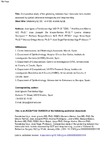Comparative study of the glistening between four intraocular lens models assessed by OCT and deep learning

Use this link to cite
http://hdl.handle.net/2183/36499Collections
- Investigación (FIC) [1685]
Metadata
Show full item recordTitle
Comparative study of the glistening between four intraocular lens models assessed by OCT and deep learningAuthor(s)
Date
2024-01Citation
Fernández-Vigo, José Ignacio; Macarro-Merino, Ana; De Moura-Ramos, Jose Joaquim; Alvarez-Rodriguez, Lorena; Burgos-Blasco, Barbara; Novo-Bujan, Jorge; Ortega-Hortas, Marcos; Fernández-Vigo, José Ángel. Comparative study of the glistening between four intraocular lens models assessed by OCT and deep learning. Journal of Cataract & Refractive Surgery 50(1):p 37-42, January 2024. | DOI: 10.1097/j.jcrs.0000000000001316
Abstract
Purpose:
To evaluate the glistening in 4 different models of intraocular lenses (IOLs) using optical coherence tomography (OCT) and deep learning (DL).
Setting:
Centro Internacional de Oftalmología Avanzada (Madrid, Spain).
Design:
Cross-sectional study.
Methods:
325 eyes were assessed for the presence and severity of glistening in 4 IOL models: ReSTOR+3 SN6AD1 (n = 41), SN60WF (n = 110), PanOptix TFNT (n = 128) and Vivity DFT015 (n = 46). The presence of glistening was analyzed using OCT, identifying the presence of hyperreflective foci (HRF) in the central area of the IOL. A manual and an original DL-based quantification algorithm designed for this purpose was applied.
Results:
Glistening was detected in 22 (53.7%) ReSTOR SN6AD1, 44 (40%) SN60WF, 49 (38.3%) PanOptix TFNT, and 4 (8.7%) Vivity DFT015 IOLs, when any grade was considered. In the comparison of the different types of IOLs, global glistening measured as total HRF was 17.3 ± 25.9 for the ReSTOR+3; 9.3 ± 15.7 for the SN60WF; 6.9 ± 10.5 for the PanOptix; and 1.2 ± 2.6 for the Vivity (P < .05). There was excellent agreement between manual and DL-based quantification (≥0.829).
Conclusions:
It is possible to quantify, classify and compare the glistening severity in different IOL models using OCT images in a simple and objective manner with a DL algorithm. In the comparative study, the Vivity presented the lowest severity of glistening.
Keywords
Glistening
Intraocular lens
Opacification
Optical coherence tomography
Deep learning
Acrysof
Intraocular lens
Opacification
Optical coherence tomography
Deep learning
Acrysof
Editor version
Rights
Copyright © 2024, Copyright © 2023 Published by Wolters Kluwer on behalf of ASCRS and ESCRS
ISSN
0886-3350
1873-4502
1873-4502





